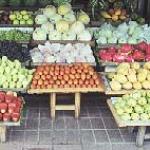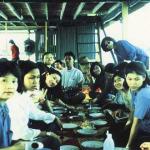An Introduction to the Food of Thailand
Worldwide, the popularity of Thai food continues to grow. It is healthy and quick, it employs a stunning variety of spices and sauces to produce heavenly gustatory effects, and it has met a need for an Asian cuisine between the heavy, spicy Indian and the subtle, almost austere Chinese. Its characteristic ingredients - coconut milk and peanuts especially - have been with great alacrity fused with those of more mainstream cuisines, often with spectacular results.
Thai dishes are named using concatenations of their basic ingredients and their methods of preparation. Kao, rice, is the staple grain, and can either be steamed (sooay), boiled (dtom), or made sticky (niew). Kao can be served on the side (lad kao) or stir-fired (pat) with its meat and sauce (kao pat). The gruel-like kao dtom, eaten for breakfast, is loaded with meat and vegetables. Kao niew, on the other hand, is usually eaten by rolling it, using one's thumb and fingers, into a ball, which is then flattened and used as either a scoop or sponge.
Otherwise, Thai food is eaten either with a spoon and fork, or with chopsticks and a shortened spoon. In the first case, the fork is used to plow food into the spoon. In the second, usually used for soups, chopsticks pick up masses of noodles or other ingredients, and place them in the spoon.
The meats of Thai food are pork (moo), chicken (gai), and to a much lesser extent, beef (neua). Seafood includes fish (bplah), squid (bplah meuk), and shrimp (koong). Knowing these, one can already order a few common dishes. For example, kao pat gai is chicken fried rice.
Thai food is generally eaten communally. Curries, soups, and salads are ordered, along with individual plates of rice. Everyone places a bit of each dish next to the rice. Each bit of food is then pushed onto the spoon along with a bit of rice, until the rice is gone. Rice is usually served in a hemispherical mound, and Thais can be quite particular about preserving its structural soundness, often leaving a perfect quarter-sphere of rice if they have only half their predicted appetite!
Soups include the fiery tom yum (usually tom yum koong), the coconut milk-based tom kha (usually tom kha gai), and the clear but savory seafood stew po dtak. But one need not travel to a restaurant to get Thailand's favorite soup, gooay teeo, a clear noodle soup usually served with balls of ground pork (look jin) or red pork (moo dairng). Almost anywhere in Thailand, one can throw a stone and hit a gooay teeo stand, which even appear on sidecars of motorcycles!
Thai salad (yum) is not your grandmother's salad. It is usually spicy or sour. Yum talay, or seafood salad, is popular, but the favorite may be som tum, a papaya salad hailing from the northeast region of Isan. Som tum's infernal flames are not for everybody, but it reputedly 'cleans out one's digestive system' - perhaps because of the diarrhea it often induces in the uninitiated.
As for curries or sauce dishes, there is the spicy southern gang looung, the coconut-milk based central curries, and the rich northern kao soy. Also popular is the red panang curry and the green gang keeo wahn, each color being that of the chili employed.
Thais also work wonders with the frying of rice-based noodles. Pat thai has, for better or for worse, come to exemplify Thai food. Combining noodles with shrimp, egg (khai), tofu, and vegetables, pat thai is then sprinkled with chopped peanuts and lime juice. An adjacent heap of bean sprouts gives the completed dish an astounding ratio of protein to fat - perhaps the key to its popularity among health-conscious Westerners. Though not as complex as pat thai, the sweet, garlic-heavy pat see eew is another celebrated noodle dish. In Thailand it can be had for less than half an American dollar, making it a filling, economical breakfast.
For the more adventurous, Thailand also offers a number of edible curiosities, found especially in the food of Isan, the country's poorest region. Here liver and intestines appear in the spicy salad larb, and pure blood in loo. Grasshoppers are fried and eaten as snacks. The people of Isan are also said to eat dog and gecko. If you find the pork you ordered in Isan difficult to masticate, you might be eating the dog your taxi almost clobbered a few minutes before.
To wash all of this food down with a liquid (nahm), water (nahm bplao) remains the beverage of choice. But Thailand also offers a grand selection of drinks made from local fruit - juices of pineapple (nahm supparot), orange (nahm som); shakes of banana (glooay pun); and, of course, lemonade (nahm manao). For tipplers, Thailand has a growing number of strong domestic beers, many of which are more akin to malt liquors - Leo, Chang, and the 'national' beer Singha (pronounced 'sing', not 'sing-ha'). The national whisky Sang Som (formerly Sang Thip) is commonly served with a pail of ice and either soda or Coke, and the Thais while away an evening concocting one drink after the other.
Thais do not eat a lot of dessert, though they make many rice-based, gelatinous confections that would serve. Abundant fruit is usually eaten instead. And, of course, there is the famous Thai coffee and iced tea, the secret of whose unsurpassed sweetness is either sweetened condensed milk or equal parts milk and a sugar syrup.
If you ask a Thai what is the greatest source of national pride, the answer is likely to be "king, language, and food", not necessarily in that order. If you ask "What is your favorite food?" you may be surprised to hear, not a particular dish, but "Thai food." If pressed for specifics, a Thai will usually disappoint. "Thai food," and only Thai food; all others are "boring, no taste." Ever more people would agree.
* * * * *
 ThingsAsian
ThingsAsian


















